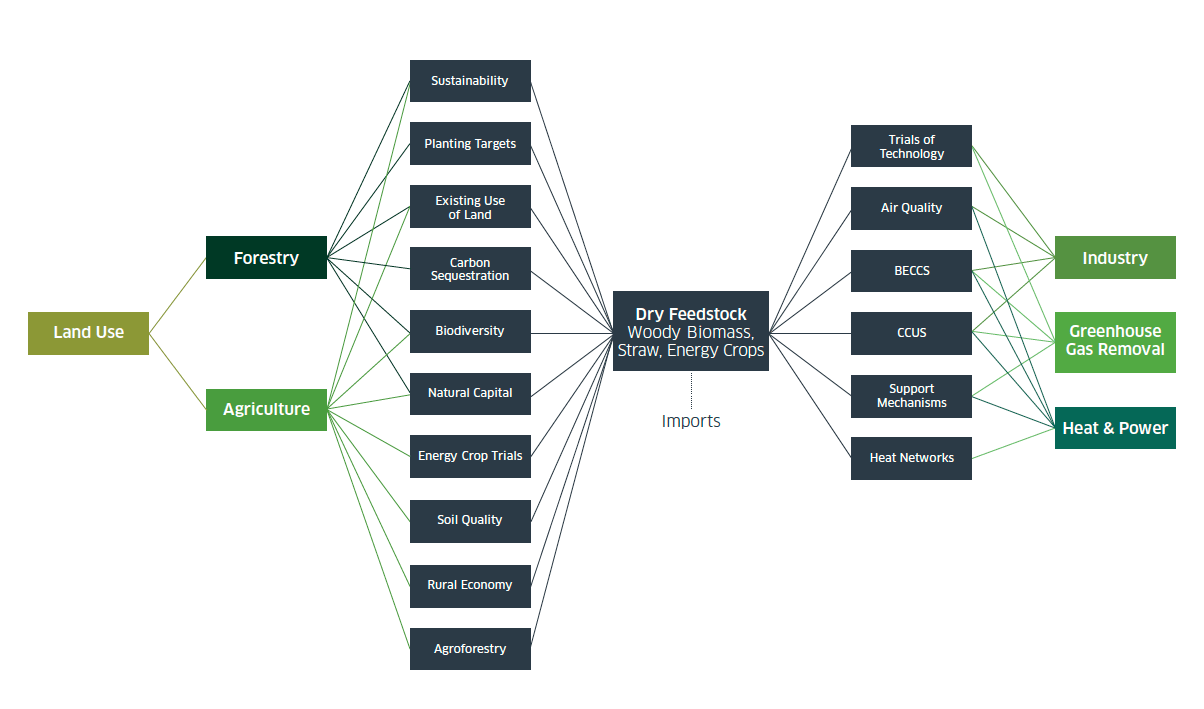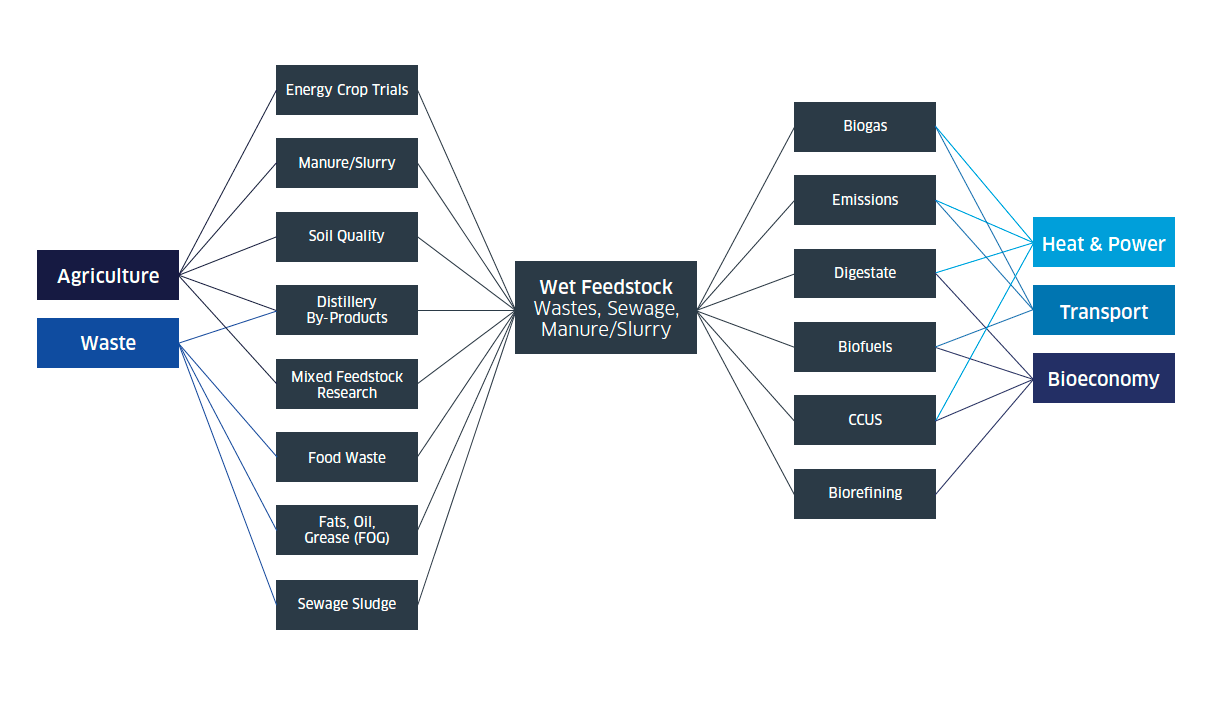Bioenergy: update - March 2021
Considers the potential role for bioenergy to support our net zero greenhouse emissions targets and outlines how we intend to move forward over the next 18 to 24 months to understand the most appropriate and sustainable use of bioenergy resources in Scotland.
6. Future Roles for Bioenergy
Relationships and Links
As highlighted earlier, there is the potential for bioenergy to play a more significant role in the transition to net zero. The recent CCC advice made clear that "sustainable bioenergy is essential for reaching net zero". An enhanced role for bioenergy would therefore require a scaling up of domestic supply, to meet anticipated future demand.
Biomass supply
Biomass feedstock is the common factor across all related sectors outlined in the previous section. See diagrams below which highlights the cross–cutting issues to be considered.


On biomass supply, the CCC indicates that fast growing energy crops can provide a rapid and therefore important source of biomass feedstock for fuel use and are recommending that during this decade, government policies should assist a transition towards use of biomass (including energy crops) as a fuel with Carbon, Capture and Storage (CCS), and away from use for heating buildings and generating power without CCS.
The CCC, are also recommending some 'wet' biomass such as food waste and sewage are likely to continue to be best used with AD, with the resulting syngas to be upgraded to biomethane and injected into the gas grid wherever possible. However, the potential location of farm based AD plants may be too far from the gas grid to allow methane injection. In these circumstances biomass feedstocks may be better used for local production of heat and power.
The "balanced net zero pathway"[13] suggested by the CCC, estimates that biofuel from waste fats/oil/grease will remain at similar levels as today for road transport. There is potential for some additional uses in off-road machinery and agricultural equipment through the early 2030s before these uses are phased out around 2040. Aviation fuel then becomes the core output, providing 6% of the UK's demand by 2050.
It is clear that we need to gather further evidence to understand the current availability of such feedstock and the scope to increase collection of it. Alongside this, we need to support innovation to optimise feedstock mixtures and increase the efficiency of the processes.
Deciding where bioenergy will be most effectively deployed will depend on which sectors will make the best use of the bioenergy feedstocks that we can grow domestically or import. The use of bioenergy resources in the energy system must also be compatible with a sustainable land use policy and our obligations to ensure a sustainable global transition.
We have already indicated in our Climate Change Plan update our intention to work to identify in which applications across the energy system bioenergy can be most effective. The work we will undertake will seek to better understand the interdependencies and relationships with the aim of producing a strategic framework or set of guiding principles.
Negative Emissions Technologies
A key issue to consider is the role that Negative Emissions Technologies (NETs) or Greenhouse Gas Removal technologies as they are also referred to, are expected to play in the pathway to net zero, compensating for the residual emissions in hard-to-decarbonise sectors, such as agriculture and international aviation.
As set out in our Climate Change Plan update, based upon TIMES whole systems energy modelling, a specific emissions envelope has been developed for NETs, allowing us to be transparent with our assumptions of these evolving technologies.
We estimate that a small quantity of negative emissions could be delivered during the late 2020s from trial and demonstrations projects. The relatively small contribution that NETs makes in 2029 (0.5 Mt) reflects this. However, in 2030 we expect NETs to begin making a meaningful contribution to meeting our emission envelopes.
There are a range of different NETs pathways, which combine bioenergy, electricity generation, fuel and hydrogen production and industrial processes. We will undertake detailed feasibility studies on NETS to assess the opportunities for negative emissions in Scotland, and identify applications with the greatest potential, including specific sites where possible. This work, will be carried out in parallel to the work being proposed for bioenergy but the findings will be made available to help inform the Bioenergy Action Plan.
With the exception of Direct Air Capture with Carbon Storage (DACCS), NETs pathways depend on the use of bioenergy. A key part of developing NETs will be to understand the implications, scale and pace with which bioenergy resources should be focused on each of the possible pathways, and how this interacts with other uses for bioenergy.
For example, where we use biomass grown or produced in Scotland we need to fully understand and consider the impacts on our agriculture and other land use sectors. Where we import biomass, it will be important to do so in a way that supports efforts to tackle the global climate emergency, which means adopting a sustainable way of using bioenergy resources produced elsewhere, and considering the growing importance of bioenergy as a pathway to decarbonisation in other countries.
The CCC has indicated that Scotland is an ideal place to deploy BECCS towards the late 2020s. In the event that BECCS is deployed at scale it will require a strategic approach to consider the interdependencies to ensure competing demands do not lead to tensions or conflicts. Primarily we will need to understand how we source and use finite bioenergy resources, while taking account of other sectors. As mentioned earlier this could be presented as a strategic framework or a set of "guiding principles".
Further Investigation and Evidence Gathering
A summary of the key areas that require further investigation is outlined below:
| Category | Further Investigation |
|---|---|
| Feedstock Availability | Dry feedstock
|
| Competing Demands |
|
| Environmental and Sustainability Issues |
|
| Technology Readiness |
|
| Reserved/Devolved areas |
|
Reserved/Devolved Levers
Some key levers in the expansion of bioenergy are currently reserved to the UK Government. Our work will seek to align with the UK Government decisions on market and regulatory frameworks. This will enable us to make the most appropriate decisions for our overall decarbonisation pathway, including a whole system approach to bioenergy and negative emissions.
Contact
Email: Lorna.Orr@gov.scot
There is a problem
Thanks for your feedback